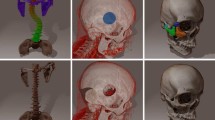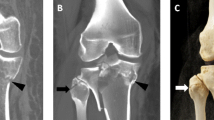Abstract
Purpose
Multi-volume visualization is important for displaying relevant information in multimodal or multitemporal medical imaging studies. The main objective with the current study was to develop an efficient GPU-based multi-volume ray caster (MVRC) and validate the proposed visualization system in the context of image-guided surgical navigation.
Methods
Ray casting can produce high-quality 2D images from 3D volume data but the method is computationally demanding, especially when multiple volumes are involved, so a parallel GPU version has been implemented. In the proposed MVRC, imaginary rays are sent through the volumes (one ray for each pixel in the view), and at equal and short intervals along the rays, samples are collected from each volume. Samples from all the volumes are composited using front to back \(\alpha \)-blending. Since all the rays can be processed simultaneously, the MVRC was implemented in parallel on the GPU to achieve acceptable interactive frame rates. The method is fully integrated within the visualization toolkit (VTK) pipeline with the ability to apply different operations (e.g., transformations, clipping, and cropping) on each volume separately. The implemented method is cross-platform (Windows, Linux and Mac OSX) and runs on different graphics card (NVidia and AMD). The speed of the MVRC was tested with one to five volumes of varying sizes: \(128^{3}, 256^{3}\), and \(512^{3}\). A Tesla C2070 GPU was used, and the output image size was 600 \(\times \) 600 pixels. The original VTK single-volume ray caster and the MVRC were compared when rendering only one volume.
Results
The multi-volume rendering system achieved an interactive frame rate (\(>\)15 fps) when rendering five small volumes (\(128^3\) voxels), four medium-sized volumes (\(256^3\) voxels), and two large volumes (\(512^3\) voxels). When rendering single volumes, the frame rate of the MVRC was comparable to the original VTK ray caster for small and medium-sized datasets but was approximately 3 frames per second slower for large datasets. The MVRC was successfully integrated in an existing surgical navigation system and was shown to be clinically useful during an ultrasound-guided neurosurgical tumor resection.
Conclusions
A GPU-based MVRC for VTK is a useful tool in medical visualization. The proposed multi-volume GPU-based ray caster for VTK provided high-quality images at reasonable frame rates. The MVRC was effective when used in a neurosurgical navigation application.









Similar content being viewed by others
Notes
The source code is available online at http://github.com/mohammeb/VTKMultiVolumeRayCaster/.
References
Zhang Q, Eagleson R, Peters TM (2011) Volume visualization: a technical overview with a focus on medical applications. J Digit Imaging 24(4):640–664
Zuiderveld KJ, Viergever MA (1994) Multi-modal volume visualization using object-oriented methods. In: Proceedings of the 1994 symposium on, volume visualization 1994, ACM: Tysons Corner, Virginia, USA, pp 59–66
Jacq JJ, Roux C (1996) A direct multi-volume rendering method. Application to visual assessment of 3-D image registration algorithms. Vis Biomed Comput 1131:53–62
Jacq JJ, Roux CJ (1997) A direct multi-volume rendering method aiming at comparisons of 3-D images and models. IEEE Trans Inf Technol Biomed 1(1):30–43
Cai WL, Sakas G (1999) Data intermixing and multi-volume rendering. Comput Graph Forum 18(3):359–368
Hadwiger M, Berger C, Hauser H (2003) High-quality two-level volume rendering of segmented data sets on consumer graphics hardware. In: Proceedings of the IEEE Visualization 2003, pp 301–308
Krissian K, Falcón-Torres C (2012) GPU volume ray casting of two volumes within VTK. VTK J
Kajiya JT (1986) The rendering equation. SIGGRAPH Comput Graph 20(4):143–150
Immel DS, Cohen MF, Greenberg DP (1986) A radiosity method for non-diffuse environments. SIGGRAPH Comput Graph 20(4):133–142
Gross MH et al (1995) A new method to approximate the volume-rendering equation using wavelet bases and piecewise polynomials. Comput Graph 19(1):47–62
Caban JJ, Joshi A, Nagy P (2007) Rapid development of medical imaging tools with open-source libraries. J Digit Imaging 20(Suppl 1):83–93
Schroeder WJ, Avila LS, Hoffman W (2000) Visualizing with VTK: a tutorial. IEEE Comput Graph Appl 20(5):20–27
Kessenich J, Baldwin D, Rost R (2004) The OpenGL shading language (language version 1.10)
Owens JD et al (2008) GPU computing. Proc IEEE 96(5):879–899
Tangen GA et al (2005) CustusX—a platform for navigated simulation and improved computer-assisted education. CARS 2005 Comput Assist Radiol Surg 1281:1374–1374
Conflict of interest
Mohammadmehdi Bozorgi and Frank Lindseth declare that they have no conflict of interest.
Author information
Authors and Affiliations
Corresponding author
Rights and permissions
About this article
Cite this article
Bozorgi, M., Lindseth, F. GPU-based multi-volume ray casting within VTK for medical applications. Int J CARS 10, 293–300 (2015). https://doi.org/10.1007/s11548-014-1069-x
Received:
Accepted:
Published:
Issue Date:
DOI: https://doi.org/10.1007/s11548-014-1069-x




